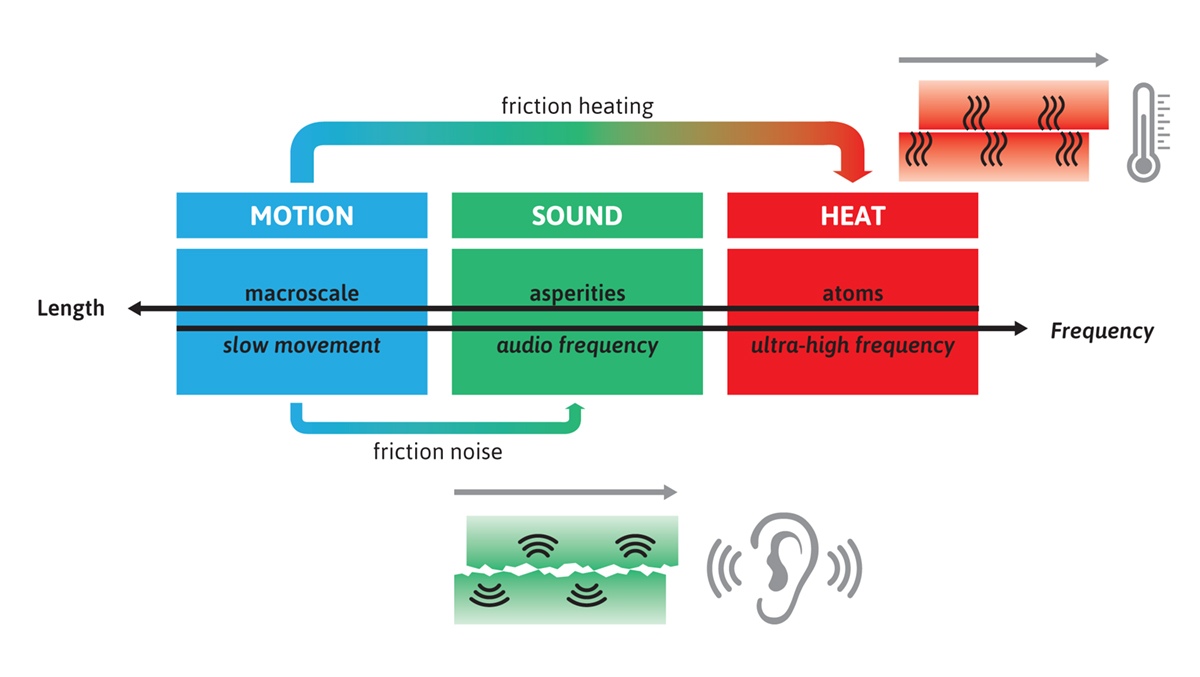Julien Scheibert & Alain Le Bot, researchers at CNRS/Ecole Centrale de Lyon explore the fascinating area of friction & sound, revealing why this is a partnership for better or for worse
Friction sound, that is sound due to the rubbing of solids, are part of our daily lives. They shape our perception of the environment, for better or for worse. Of course, the sounds made with musical instruments, such as a violin delight our ears (figure 1). But many others such as the squeak of doors, or the squeal of brakes are aggressive or can even scare us, as evidenced in the squeal of tyres during emergency braking. We estimate that the rolling noise emitted by cars is the first cause of noise pollution in the urban environment. Noise annoyance in our cities has become a recognised public health issue, the treatment of which remains a true social challenge, with considerable medical costs for our society.
The industrial challenges are no less important. How does one design a noiseless road? How do we avoid the squealing of brakes or belts? What can we learn about the health of our devices by scrutinising the sound they emit? Is it possible to design our environment to increase our acoustic comfort? More generally, the question is how to control the friction sound of our everyday life equipment to make our lives more pleasant and safe?
All these questions demonstrate the necessity to increase our scientific understanding of friction sounds. One thing is already certain: tribologists (the scientists studying friction) and acousticians (the scientists studying sound) will be partners in this battle to save our ears.
Indeed, if there is noise, there is some rubbing somewhere! And the noisier something is, the stronger the underlying friction. Haven’t you ever thought that your windows would be cleaner if the rag would make a substantial noise? Don’t you feel that your hair is cleaner when shampoo makes a stronger squeal noise? But the relationship between friction and its noisy consequence could turn out to be subtler than it appears at first sight.

So, what can tribology teach us about the physical processes that cause friction sounds? To answer this question, one must dig into the small scales of the contact surface itself. Surfaces are never perfectly smooth, but as soon as we zoom in, we discover complex landscapes made of asperities with random shapes and heights. As a consequence, a sliding contact, which might appear as homogeneous at a large scale, actually consists of discrete collisions between asperities, at random locations and instants. All those rapid collisions act as tiny hammer strokes, which excite the vibration of the whole rubbing body, finally inducing the sound that reaches our ears1. From this scenario emerges a dynamic picture of friction, with a key role of short time scale effects, which remain poorly understood in tribology. Increasing our knowledge of dynamical effects in friction, like sound, is actually central in the scientific strategy that we implement in our lab.
More tribology helps us to understand sound. This is okay, but the opposite question is one worth raising: to what extent can acoustics help us to understand the elementary mechanisms of friction? Friction is an energy dissipating force whose physical origin remains elusive. Even today, after centuries of research, friction is still an important scientific challenge in modern physics. Like all dissipation mechanisms, friction must be considered as a thermodynamic process which transforms a “noble” form of energy – macroscopic motion – into a “degraded” form of energy – heat. It is well established that heat is a vibrational energy at the scale of atoms. What about the friction sound? As discussed above, it is also a transformation of energy from a macroscopic motion into a vibration but operating at the scale of contact asperities2. A simple idea thus emerges: the difference between sound and heat may just be a question of scale3 (figure 2). Both are vibrations, but heat simply involves smaller length and time scales, making it impossible to be detected by our ears.
Can we use this analogy to suggest useful hints about how friction research should be organised? The community does agree on the central role of the so-called “energy budget”. This term simply means that if we could quantify the energy dissipated in all the possible forms, mainly heat and vibrations, we would understand friction. The direct implication is that friction studies should, as much as possible, involve close collaborations between tribologists and acousticians. Tribology labs should open their doors to more vibration scientists, a strategy that we have been pursuing for several decades in our own institution. Similarly, seismologists (the acousticians of Earth) would benefit from an alliance with tribologists to elucidate the triggering mechanisms of earthquakes, the friction noise of the Earth’s crust. The fruitful partnership between tribologists and acousticians, therefore, has a bright future.
Please note: this is a commercial profile
References
1 A. Le Bot, J. Phys. Conf. Series 797, 012006 (2017).
2 A. Le Bot et al., Entropy 12, 2418-2435 (2010).
3 A. Le Bot, Foundations of statistical energy analysis in vibroacoustics, Oxford University Press (2015)
Julien Scheibert
Researcher
CNRS/Ecole Centrale de Lyon
www.ec-lyon.fr/contacts/julien-scheibert
Tel: +33 4 72 18 62 26
Alain Le Bot
Researcher
CNRS/Ecole Centrale de Lyon
www.ec-lyon.fr/contacts/alain-bot
Tel: +33 4 72 18 62 75











